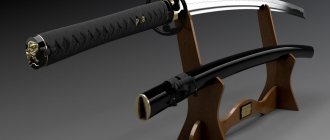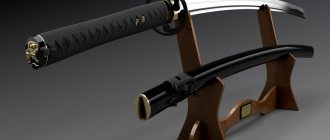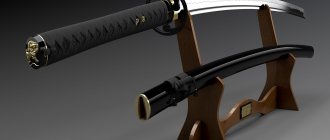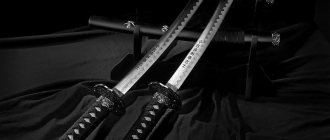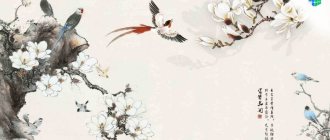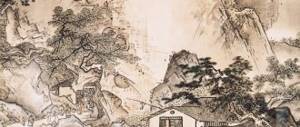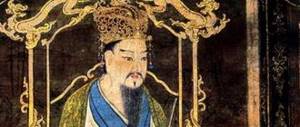A katana is a samurai sword with a curved blade, sharpened on one side, and a straight wooden handle. It was worn and stored in a magnolia sheath.
The size of the weapon is 95-105 cm, the blade is 60.6-75.7 cm, so it is classified as a cold weapon. The cutting part is made of several types of steel, it is both strong and sharp, and holds an edge for a long time. The katana was used in honor fights, held with both hands, but a grip with one hand is also possible.
The cost of an ancient weapon now reaches several thousand dollars; replicas from Japan can be bought for 2.5-60 thousand rubles.
Main characteristics of the katana
The katana has the characteristics indicated in the table.
| Options | Their meanings and features |
| total length | 95-105 cm |
| Blade length | 60.6-75.7 cm |
| Blade width | Up to 3 cm |
| Butt thickness | Up to 0.5 cm |
| Blade sharpening | One-sided |
| Sharpening angle | Up to 40-45 degrees in the middle part, up to 39 degrees at the tip |
| Handle | Straight, wooden, covered with shark skin, wrapped with silk cord |
| Handle length | 3.5 fists of the owner, that is, 25-30 cm |
| Blade steel | Combination of high carbon hardness 60-62 HCR with medium and low hardness material |
| Garda | Available, diameter – 7.5-8 cm |
| Presence of a scabbard | Necessarily |
| Is it a bladed weapon? | In most cases it is, but there are exceptions |
What is a katana
Katana is a Japanese edged weapon that belongs to the category of swords, although it is similar to a saber or checker. It has been known since the 15th century, it was owned by samurai. The weapon has a long, slightly curved blade, consisting of several layers of steel of different hardness, and a short handle in comparison with it. The katana was intended for delivering cutting blows, but with skillful use it could also stab the enemy.
Weapon length
The length of the katana together with the handle, that is, the full length, is 95-105 cm. The blade should be 60.6-75.7 cm, but on average this figure is 70-75 cm. That is, weapons of this type with shorter blades are much more common less often. This difference in the size of traditional weapons is due to the fact that they were personal and were made in accordance with the dimensions of the owner.
We recommend reading the article about the coolest knives known throughout the world. From it you will learn about the sharpest, most dangerous and beautiful knives, the ranking of the best knives in the world, the highest quality and most popular in Russia. And here you can read more about the benefits of the Nepalese kukri knife.
Dimensions
In addition to the length of the blade and the overall length, the following dimensions of the katana are important:
- the width of the working part is approximately 3 cm;
- butt thickness – from 0.5 cm.
These are the dimensions of the katana in centimeters, but in Japan the length of the sword was determined in its own units of measurement, and it had to be from 2 shaku.
There were no clearer criteria in manufacturing, especially when it came to the length of the handle. It was determined by the size of the weapon owner’s hand and was supposed to be 3.5 times his fist.
Katana weight
The weight of a katana varies from 1 kg to 1.9 kg. It depends, of course, on its size, but also on the forging method, the features and the number of different types of steel used. The nuances of the decor of the handle are also important. It should have cast decorations that increase the weight of the weapon. But it cannot fall out of the standard boundaries, otherwise it will be impossible to use the katana in the proper way.
What does it look like
The katana looks like a powerful sword with a slightly curved long blade and a straight hilt. The latter is separated from the chopping part by a hand guard - a guard.
The blade of the weapon is slightly beveled and rises up at the tip. In addition, the handle is decorated with decorative metal elements, covered with stingray or shark skin, and a silk ribbon is fixed over it in several turns. All this helps to hold a heavy weapon more securely in your hand.
Structure
The structure of a katana according to the regulations looks like this:
- Ha – cutting edge of the blade;
- Nakago – base of the cutting edge;
- Mekugi – Nakago bamboo fastener in the handle;
- Habaki - a fixing device for a blade so that it does not move;
- Tsuka – handle;
- Kasira – the head part of the handle;
- Monouchi - the surface of a weapon that strikes when struck;
- Mune - the unsharpened end of the blade;
- Shinogi - edge of the blade;
- Tsuba - guard.
- Saya – scabbard;
- Koi guchi is the place of entry into the sheath;
- Sageo – rope.
These are the main parts of the katana. The sheath is also an integral part of the samurai weapon, since it was worn on the belt not naked, but hidden in it. Sai allowed not only to keep the sword sharp and not rusty, but also to disguise it after the ban on wearing it was introduced.
The secondary components of the katana are:
- Ada – patterns formed during rolling;
- Hamon – hardening boundary;
- Dzi-ada – blade;
- Ha mati - the edge of the cutting edge of the blade;
- Kissaki - blade tip;
- Ko-sinogi – edge at the edge;
- Boti - the hardening boundary at the edge of the blade;
- Yokote is the dividing line of the tip;
- Mune mati - the edge of the blunt tip of the blade (Mune);
- Shinogi-ji - flat surface of the blade;
- Nakago-jiri – the final section of the cutting edge (Nakago);
- Mei – inscriptions on the base of the cutting edge (Nakago);
- Yasuri-me - notches on Nakago;
- Nagaza – the size of the blade;
- Sori - blade deflection;
- Yaki-ha – hardened portion of the blade;
- Menuki - ornament on the handle;
- Same-hada – fish skin, covering the handle;
- Kurikata – rope loop (Sageo);
- Shitotome - a hole through which a loop for a rope (Kurikata) is threaded;
- Footi – handle coupling;
- Sepa - washers;
- Tsuka-ito - silk cord wrapped around the handle;
- Kojiri is the end point of the sheath.
Blade
The katana blade has a one-sided sharpening, its line has a smooth bend. It should be finished to a razor-like finish, tapering to a point or be uniform along its entire length.
In the first case, the masters achieved the following indicators:
- the middle part (from 2 cm from the guard to the middle of the blade) was sharpened to 40-45 degrees;
- the upper part (from the middle to the tip) was processed to 39 degrees.
And the maximum thickness of the blade spine is 5 mm. This combination of sizes of blunt and sharpened edges gives the sword special fighting qualities.
The required thickness of the katana blade was achieved, among other things, by polishing at the final stage of manufacturing. First, it was sharpened with rough stones of varying abrasiveness, then processed with more delicate material. The sharp edge of the blade should be smooth, without jagged edges.
Sword steel
Steel for a katana must have a high degree of carbon content, that is, be a hardness of at least 60-62 HRC. But the blade is always made multi-layered, that is, several varieties of it are used and different ways of combining them.
Mild steel or steel combined with medium steel gives the weapon elasticity, which means it does not break under heavy load. Hard provides the blade with high sharpness for a long time.
The methods of combining different types of steel differ. Sometimes the soft and middle layers are the central layers of the blade, and the hard lining is on the outside. In other cases, the high carbon steel is on the inside and the outer layers are made of lower carbon content material.
Blade designs according to the types of steel used are of the following types:
- maru, in which there is only one type of material - high-carbon;
- kobuse, where the rod is made of soft steel and the lining of harder steel;
- khonsammai, in which the inner layer is soft, but the tip is high-carbon, and there are outer linings of a medium-hard material;
- Shihozume, similar to the previous design, but with the back of the blade protected by a strip of medium-hard steel;
- makuri, where the core is soft and the shell is completely hard;
- warha tetsu, in which the tip is made of high-carbon material and the lining is made of soft material;
- orikaeshi sammai, which is an improved form of honsammai;
- gomai, where the thin inner rod is made of hard steel, it is covered with a layer of soft material and again hard material on the outside;
- sosu kitae, which combines seven layers of different types of steel, which gives the highest possible quality.
Katana is a saber
A katana is a saber by European and Russian standards. It is classified as this type of weapon because of its curved blade and its one-sided sharpening.
But the Japanese are sure that the katana belongs to the category of swords for the following reasons:
- it is used primarily for cutting and piercing blows, and for chopping with a saber;
- the handle continues the line of the blade, and does not bend;
- the weight corresponds to the same indicator of other swords, and the second type of weapon is much lighter;
- You can operate a katana by taking it in your left, right hand, or holding it with both, which will not work with a saber.
Watch the video of an expert's opinion about the Japanese Katana sword:
Is it a bladed weapon?
A katana is a melee weapon if its parameters fall within the formal characteristics of weaponry reflected in GOST R 51215-98. There are definitions of sword, blade, blade, point, consistent with what can be seen in most antique products of this type. If an ancient katana or replica has discrepancies with the requirements of the standard, they cannot be called a bladed weapon.
A product may exclude, for example, one of the following characteristics from the chemical weapons category:
- movable connection of the blade with the handle;
- an unsharpened blade that cannot cause cutting damage;
- blunt edge, with no chance of causing a puncture wound.
If they are not there, the katana can be a historical property, a collectible, an antique, and in all cases it is required to have permission.
Longest katana
The longest katana is called "okatana". Belonging to this subtype of weapon is determined by the size of the blade; it must be larger than 2.5 shaku, that is, from 75.8 cm. The largest full size of a long sword is 105-130 cm. The shape of the blade and handle in all cases is the same as that of a traditional weapons of this type.
Katana
Sword design
The design of a katana has many elements.
A katana belongs to complex swords made from several metals. Often two alloys are taken - soft for the core and hard for the outer side. The final design of the weapon is divided into many elements that determine the quality of the sword.
The general appearance of the katana has a slightly curved shape. The arc formed has a larger radius than its predecessor, tati. The curve of the sword (sori) is a consequence of the evolution of Japanese weapons and fighting techniques. Experiments were carried out in this direction for a long time until the current variation was achieved.
Blade
Components of a katana blade
The combination of a soft (viscous) core and a hard (hard) shell provides the weapon with long-term sharpness and toughness. Otherwise, hard steel would be brittle, and soft steel would quickly wear off.
The katana blade is sharpened only on one outer side. Numerous myths attribute phenomenal abilities to samurai swords, including cutting iron and stone. A carefully crafted and hardened katana blade is indeed highly durable, but its properties are often exaggerated.
The katana does not have clearly defined standards for bending, cross-section, thickness and other elements. They differ depending on the master, the blacksmith school and the purpose of the blade. For example, against armor the sword was made heavier with a wedge-shaped cross-section, and against opponents unprotected by armor a thin blade was suitable.
Handle
Elements of the handle
Making the handle is considered the final stage of creating a sword and follows after grinding the blade. The handle is secured to the shank using a conical bamboo wedge. Despite the apparent simplicity of the design, there are several components of the handle:
- habaki - a clutch that fixes the position of the sword;
- tsuba—guard;
- seppa - washers above and below the guard;
- footi - coupling between the guard and the handle;
- Samegawa - handle coating;
- tsuko-ito - braided braid;
- menuki - decorative inserts;
- kashira - a cap at the end of the handle.
The primary covering of the handle is made from the skin of a stingray or other sea animal. Silk or leather is used as braid, and wool is used for decorative decorations. Modern swords are trimmed with artificial silk. All decorations and decorative elements are made in the same style.
Sharpening
Sharpening a katana is carried out together with grinding; this process is often carried out by another master - togishi. First, he polishes and sharpens the blade of the weapon with coarse stones, and gradually moves on to finer ones. This procedure takes about 120 hours.
As the sharpening progresses, the master determines the structure of the metal and the forging technique. At this stage, minor defects that arose during the manufacturing process are eliminated. An important aspect of the work is the preservation of the style of the blacksmith who made the blade. This should be especially taken into account in the decoration of weapons and their aesthetic beauty.
Engravings
The engraving is applied by the master after polishing to the unhardened areas of the sword. This element is considered decorative; combat katanas are rarely decorated. On modern weapons, engraving is carried out mainly on Buddhist themes.
Dimensions and weight
Comparison of sizes of Japanese weapons
Katana does not have exact standardized dimensions and weight. Hand-made weapons imply the individuality of each sword. However, there are certain frameworks by which katanas are distinguished from other types of Japanese weapons.
The length of the blade varies from 60 to 75 cm (2-2.5 shaku). The total length with the handle ranges from 85 to 105 cm. If the length is less than the established size, it is a wakizashi. If more - o-katana. If there is a larger bend and size, the sword is classified as tachi.
Depending on the craftsman and the tradition of katana making, the weight of the weapon differs. The approximate range is 0.7-1 kg. The mass differs not only from the size, but also from the metal used and the technique of its processing.
History of the Samurai Sword
The samurai sword dates back to the end of the 14th century. The predecessor of the katana was the tati sword; in fact, thanks to its improvement, it appeared. The weapon was carried and used in combination with a short wakizashi. The latter is also classified as a sword.
The katana was an indispensable attribute of samurai weapons until the 20th century. True, it was previously banned from using it. But the Japanese began to hide weapons in simple wooden sheaths to create the impression that there was the same wooden sword there. Then tools with thinner blades appeared, similar to European cane swords. They forced the katana out of use, as they were more convenient to camouflage.
Watch the video for the history and review of the samurai sword Katana:
Scope of application
The katana was the personal weapon of the samurai, confirmation of his status. But also a weapon of defense, often used in duels. When determining its purpose, we can draw an analogy with the European sword or rapier. But, unlike Western weapons, the katana is not capable of damaging the armor of a samurai, especially if it was created before the 17th century. Those swords have a too fragile blade due to the high sharpness of the blade. But this did not stop them from being used in close combat with an enemy without armor.
Now the katana is not only a collectible weapon. Swords are used in fencing. There are several schools in Japan that teach the art of wielding this weapon.
The difference between the Japanese katana and its European counterparts
Daisho is a combination of a large and a small blade.
Cultural traditions and methods of combat are especially evident in the weapons made. The key differences between European and Japanese swords are their appearance and their purpose.
The bastard swords of Europe, to which the katana is more comparable in size, delivered slashing blows. This weapon was considered the main weapon and determined the superiority of a warrior in battle.
The samurai sword was often considered an auxiliary weapon to the bow. They were dealt cutting blows, the fight was designed for speed and dominance of the first blow. In a direct clash with a European bastard sword, the katana loses - it is heavier, wider, and the quality of the steel is not inferior to Japanese weapons.
Many myths are associated with the manufacturing technology of samurai swords, on the basis of which fantastic properties are attributed to katanas. This topic and myths are especially popularized in popular culture.
The alternation of multilayers of hard and viscous metals was known in Europe already in the 3rd century BC. In addition, in Europe, already in the 14th century, a blast furnace was invented, which made it possible to better purify raw materials from impurities. In this context, the quality of European weapons was not inferior to Japanese ones.
For Japanese craftsmen, the main difficulty in manufacturing was obtaining purified metal. Since the 16th century, blacksmiths began to use imported European steel, which greatly facilitated the production of samurai blades.
Many draw conclusions about the quality of Japanese swords based on the number of preserved samples. In Europe there is not a large number of weapons preserved in good condition to this day. Because of this, the conclusion is mistakenly drawn about its low quality.
The preservation of Japanese blades is due to traditions and careful care of weapons passed down from generation to generation. The sword became the property of the family and had its own history. According to legend, it contained the spirits of all previous owners.
In Europe, this attitude towards weapons manifested itself to a lesser extent. To a certain extent, this is due to the availability of resources for the manufacture of new blades. The process itself, due to better technical development, was also characterized by greater simplicity and less time.
How to hold and wear a katana sword
You can hold a katana either with one hand or with a two-handed grip, but the latter is more convenient. In this case, the blade of the sword goes to the target not at a right angle, but obliquely, to deliver a cutting blow. This technique was previously used in combat, and now it is used in fencing.
They wore a katana in a sheath, where the sword lay with the tip up. They were held behind the belt on the left side. Upon entering someone else's house, the samurai removed the weapon from its sheath and placed it nearby so that it could be reached.
The katana sword, held by the hilt with the left hand, indicated the samurai’s readiness to engage in battle. If it was on the right, it meant the owner had a peaceful attitude.
Katana is the strongest sword in the world
The technology for producing a katana is very complex - special processing of steel, multi-layer (multiple) forging, hardening, etc. Katanas are the strongest swords in the world, they are capable of cutting materials of almost any hardness, be it meat, bones, iron. Masters skilled in the art of fighting with a katana in a battle with a warrior armed with an ordinary European sword could cut this sword into two parts, the force of a samurai’s blow and the steel of a katana allowed this to be done (Monuchi is the part of the blade blade of a Japanese bladed weapon, which accounts for the main force blow).
The katana could be used to stab and chop equally easily. The long handle allows you to actively maneuver the sword. In this case, the main grip is the position when the end of the handle rests in the middle of the palm, and the right hand holds it near the guard. The simultaneous movement of both hands allows you to describe a wide amplitude with the sword without much effort. Both the Katana and the straight European sword of a knight weigh a lot, but the principles for performing cutting blows are completely different. Most of the blows are delivered in the vertical plane. There is almost no division into “block-strike” accepted in Europe. There are knocking blows to the enemy's hands or weapons, throwing his weapon away from the line of attack and making it possible to deal a damaging blow to the enemy at the next step.
Types of katanas and their varieties
There are the following types of katanas:
- traditional;
- wooden, used as a souvenir;
- short - wakizashi;
- straight – kokatana;
- tactical – Tactical Katana Machete;
- with a red blade, where the steel contains gold.
There are also ancient and modern varieties of katanas. But the latter can be of no worse quality than those that have existed for several centuries, since the secrets of their manufacture are preserved and used by Japanese craftsmen.
Wooden katana
A wooden katana is a souvenir weapon used for historical reconstructions or in games. The sword is made entirely of solid beech, including the hilt. Other types of wood can also be used. The handle of the product is trimmed with genuine leather. This katana resembles an ancient samurai weapon only in shape.
Short katana
The short katana is a wakizashi sword. Both were worn as a pair on the left side of the belt, and were called a "daise" set.
Wakizashi has:
- length 50-70 cm,
- handle the size of 1.5 fists of the owner,
- blade 3 cm wide,
- butt 0.5 cm.
Wakizashi sword
But otherwise, it completely repeats the shape of a katana - a blade curved with a sharp edge and a straight handle. This weapon served as an auxiliary weapon in battle if the long sword broke or it was not possible to reach it.
The small katana was always with its owner if he found himself in someone else's house. And in this case the big one had to be removed from the belt and placed next to it.
Straight katana
The straight katana is called "kokatana". It could be included in a daiso instead of a wakizashi, that is, serve as a reserve weapon for a samurai. Kokatana has the following parameters:
- full length 60-69 cm,
- handle 15-17 cm,
- less curved, but not absolutely straight blade up to 3 cm wide.
Kokatana Sword (Ko-Katana)
And, unlike wakizashi, only aristocrats could wear a kokatana.
Tactical katana
The tactical katana has almost no relation to the ancient Japanese weapons, since it is a modern knife from Cold Steel called the Tactical Katana Machete. It is similar to a samurai sword only in shape - a curved blade, pointed at the convex edge, and a straight hilt.
Tactical Katana Machete parameters:
- total length – 92 cm,
- blade length – 61 cm,
- length of the sharpened blade segment – 57 cm,
- blade width – 3.3-4.5 cm,
- butt thickness – 2.2-2.4 cm,
- guard diameter – 7.7 cm,
- handle thickness – 2.1-2.8 cm.
Tactical Katana Machete
The metal part is made of carbon steel. The handle is made of polypropylene and features the finish pattern of a real katana. The set also includes a fabric case with plastic trim.
Dual katanas
Paired katanas are daisho, consisting of the katana itself and a shorter wakizashi. Another option for a samurai's weapon set is the first sword and straight kokatana, hung on the belt on the left side. But they never carried or fought with two katanas at once. The first is inconvenient, the second is unrealistic due to the size and weight of the weapon.
Paired Katanas
Katana with red blade
A katana with a red blade is one with a blade made of red steel, which contains gold and brass. This feature does not enhance the combat qualities of the weapon, but makes it very attractive in appearance and quite expensive. Usually the hilt and scabbard also have a red color to them.
Katana with red blade
Crossed katanas
Crossed katanas are nothing more than a symbol of readiness for battle. But in reality, it is impossible to see both weapons in the hands of the owner in exactly this position. Daise cannot be used at the same time. Crossed swords are marked only on graphic images, family coats of arms, and symbolize the military valor of the samurai family.
Reasons for popularity
The two-handed katana is in demand among collectors because this weapon is distinguished by its beauty and originality. Films in which valiant samurai wielded two swords at once (which is unlikely in reality), defeating everyone, contributed their share of popularization.
Another myth that adds interest is that weapons cannot be broken. This is due to information about the peculiarities of steel production and blade forging by the Japanese. Both processes are different from how it was done in Europe. And the very interest in Japan also contributes to the popularization of its ancient swords, even in the form of their modern replicas.
Why are so many ancient weapons preserved?
The Japanese were sensitive to weapons, passing them on to their descendants in each family. Samurai swords were of high quality and richly decorated, so they were the property of the family along with lands and monetary property. Accordingly, they were stored carefully; many weapons have survived to this day.
There are other reasons for the abundance of swords:
- there are more than 300 forges in the country that make weapons using ancient technologies;
- they are in great demand in Japan, thanks to interest in the art of swordplay and the schools where it is taught;
- The ancient guns are a cultural and historical treasure of the country, protected by scientific societies, so they were not allowed to be destroyed after Japan's defeat in World War II.
Interesting Facts
Rule 34, or that’s where it belongs Gothic katana in German
- Ninjato (lit. "ninja sword")
- a special version of the katana with a straight blade and a square tsuba guard, supposedly worn by ninjas - is in fact simply the cheapest version of the katana, used by ashigaru foot soldiers and the poorest of the samurai in the 16th-17th centuries . - The possibility of cutting a person in half from the shoulder to the waist - it is possible that it is true. Here the notorious Japanese cuisine comes under suspicion, or rather the huge amount of rice consumed by the entire population without exception. The fact is that this product helps to wash out calcium from the bones, which is why they become soft. The further logic is clear. The shoddy nature of Japanese armor also played an important role, as well as the fact that since the Edo era, fights with katanas, as a rule, took place without
armor. - Another feature is the disassembly of the katana. Therefore, not only fully assembled swords, but also blades, tsuba and menuki - decorative elements are of collectible value[5]. There is even a special option for sealing the blade, designed specifically for storage - the so-called. “shirasaya”, an undecorated sheath and a handle without a guard made of soft acacia wood, into which the blade was put away “for rest” during the period when it was not intended to be used. By the way, since such a sword did not have protruding parts and was very easy to hide in baggy Japanese clothes, it was precisely this mounting of the blade that the Japanese bros from the Yakuza and others like them really liked.
manga , Ota Masanori, goes by the pseudonym Masamune Shiro, where Masamune is the name of the legendary blacksmith of the Middle Ages, whose work was credited with almost divine characteristics;
they are now recognized as national treasures of Japan. The name of the main character of GITS, Major Motoko Kusanagi, is taken from an ancient legend in which Kusanagi is the name of a sword (in importance at the level of Excalibur). The main joke here is that Kusanagi is not a katana
, but a tsurugi - a straight sword of continental Korean origin, a close relative of the Chinese jian.
- a harsh weapon of mercenaries, a curved blade on a two-handed handle, which was popular along with two-handed swords and flamberges. The weapon turned out to be forgotten after the mass arming of infantry with firearms, because if a two-handed sword was at least a mega-pretentious weapon that even a noble knight would not be ashamed to wave, then the Kriegsmesser did not have such a pedigree.
How much does a katana cost?
How much a katana costs depends on the age of the weapon, the manufacturing method, the finishing features of the handle and sheath, but a modern “remake” of good quality can cost 10-60 thousand rubles. A product of a worse level costs only 3-4 thousand rubles. A real katana from Japan will cost 300-500 thousand rubles, and sometimes even higher if it is a copy from a famous master with supporting documents. In 1995, one of these was sold for 600 thousand dollars.
Where to buy real one from Japan
You can buy a katana from Japan in gun stores. There are products made in this country at the present time, but in accordance with previous traditions. They can also be ordered online at international sites.
In Russia and other countries there are private collectors of weapons, who also sometimes part with some of their weapons. But you need to remember: if the sword has signs of chemical weapons, you will need permission to own it.
Advantages and disadvantages
The handles of modern products are richly decorated in a given style.
If we exclude all the myths planted by movies and games, the katana remains a high-quality, but ordinary weapon. The blade took into account the fighting technique of Japanese warriors and evolved in accordance with it.
The advantages of a katana include its lightness and curved shape, which allows for quick cutting blows. The weapon was used as a two-handed or one-handed weapon paired with a short blade. Excellent for fighting opponents unprotected by armor.
The disadvantage of katana is the long forging period and the complexity of manufacturing. High-quality swords were made for samurai, however, they also had certain shortcomings. The thinness of the blade and sharpening made the blade vulnerable to improper impacts on a hard surface. Many surviving blades have chips and nicks, indicating the limited use of the katana.
The katana also does not stand up to comparison with its European contemporary - the bastard sword. Many people consider the Japanese sword to be lighter and faster, but this issue remains controversial. The one-and-a-half blade is only 300-400 grams heavier and is distinguished by its balance and maneuverability.
The blade of the one and a half blade is thicker, the sharpening is not so sharp, however, it is more reliable for long battles and impacts against armor and shields. This also simplifies mastering the European sword, which does not require the beginner to concentrate on the accuracy of the blow.
In this context, the katana is an excellent weapon that became in demand in numerous internecine wars of Japanese feudal lords. However, talk about its exclusivity over any other bladed weapon is nothing more than a myth created by popular culture. In most cases, the advantages and disadvantages of a weapon are determined by its use and the skill of the owner.
Making a Japanese katana sword
Traditional katana making is a labor-intensive and lengthy process that includes:
- cleaning steel from unnecessary impurities by immersing it in a solution of clay and ash;
- heating to high temperatures and folding with hammer flattening to obtain a multi-layer sheet of high-carbon material;
- forging, during which steels of different hardness are combined and the outline of the blade is formed;
- hardening of a workpiece coated with a layer of liquid clay so that martensite appears in some areas of the metal;
- release of material that already has the shape of a blade;
- sharpening and polishing, during which the modern Japanese katana sword acquires engraving on the working part;
- making steel guards and decorating them;
- making a handle, connecting it to the blade and guard using a bamboo fastening;
- making wooden scabbards.
Cheap modern samurai swords are made from simple stainless steel with a hardness of 56 HRC. And in this case, the process of creating them is not so complicated, it consists of cutting the blade, hardening, tempering, sharpening, making a handle and sheath, and assembling the product.
How a katana is made in Japan
Katana in Japan is made as follows:
- Pieces of special grade steel are placed in ash and clay solution to remove slag. Then they are removed and heated to join into a single whole, hammered, folded, and the previous step repeated until a sheet of high-carbon steel is obtained.
- A softer material is added to it to impart viscosity, which protects the blade from breakage. Forging takes several days, strips of steel of different hardnesses are combined in the way they will be arranged in the finished product. When the initial form is ready, a layer of liquid clay is applied to it.
- Next, in the process of hardening (heating the workpiece and cooling in warm water), a hamon is formed, that is, a pattern in the area between the blade and the transition to the butt. It will become final after polishing the blade, but first the latter is given a traditional shape - slightly curved.
- The next stage is product release. It is heated in an oven and cooled slowly in air. This is how the blade gains hardness without losing its viscosity.
- The finished metal part of the weapon is sharpened. To do this, use up to 9 special stones of different abrasiveness, and at the end - thin plates or wooden planks. At the same stage, some modern craftsmen apply engraving to the unhardened areas of the blade.
- All that remains is to polish the product. The master also works with different tools, thanks to which he highlights sections of the blade (hamon, hada, etc.). Along with sharpening, the process can last several days.
- Then a handle is made from magnolia or cherry, covered with stingray or shark skin, wrapped with silk, sometimes woolen ribbon. It is attached to the shank using a bamboo pin threaded through a hole on it. Between the handle and the working part of the blade there should be a guard (tsuba), attached using washers (sep). A coupling (futi) should separate the hand protection from the handle.
- The scabbard is made from wood. They are framed with decorations made of animal horn or bone and coated with varnish.
Watch the video about how samurai Katana swords are made:
Yaki-ire: Blade Tempering
Tempering the blade is the most important and most difficult aspect of the sword making process. For a blacksmith-gunsmith, the hardening operation is like the final stroke in a painting for artists. It is a matter of success or failure of the entire work, one might say it is a matter of life and death for the sword. It is the hardening of the blade that gives the blade the ability to perceive and maintain an amazing sharpness.
First, the blade is coated with yakibatsuchi, a mixture of water, clay, ash and other ingredients. Each blacksmith has his own special recipe, which is often kept secret. Yakibatsuchi is applied on the surface, thicker at the spine and thinner at the edge. Working in a darkened forge, using only the light of hot coals, the blacksmith carefully heats the blade. As the temperature increases, the crystal structures in the metal begin to change. The blacksmith carefully observes the color of the luminous blade, and when a critical temperature is reached, the sword is quickly hardened in a tub of water.
At the critical temperature, around 750°C, the structure of the steel changes to austenite, a phase in which carbon is completely combined with iron. When a blade is rapidly cooled by quenching, austenite turns into martensite, the hardest type of steel. However, where a thick layer of yakibatsuchi has been applied, the blade will cool more slowly, not turning into martensite, but instead forming ferrite and pearlite, which are softer and more flexible. Like the kawagana and shinana, this combination of a hard edge and a softer body is what gives the blade its desired qualities.
Edge hardening also creates a visible change in the surface of the metal. Depending on how the clay mixture was applied, a variety of effects can be achieved. This edge pattern is called a hamon and is one of the most important aspects of a blade's aesthetic appearance. Like jihad, each of these patterns has a specific name. Suguha, for example, is a very straight hamon, while sanbonsugi describes a zigzag line.
Sword Guardian (Tsuba). Ishiguro Masayoshi (Japanese, 1772–1851)
Common defects of the samurai katana
A samurai katana is obtained as a result of a complex technological process, errors in which can lead to the appearance of defects that have certain names:
- Karasunokuchi – damage to the blade. If a crack penetrates the hardened and unhardened parts, the sword cannot be repaired; it is unusable.
- Sinae - transverse cracks in bend areas. They arise due to “fatigue” of the material and do not interfere with the use of the tool.
- Fukure are pieces of scale or coal preserved during the process of folding steel. The flaw spoils the appearance, as it is exposed after polishing. In addition, it reduces the strength of the sword.
- Kirikome - irregularities on the back of the gun. They form as a result of using a sword, but the problem is dealt with by polishing or not dealt with at all, since it is not considered serious.
- Umegane is a patch that hides another defect. It is placed by a blacksmith, wanting to correct mistakes in his work or make the visible inner layer of steel invisible.
- Hagire is a crack on the hardening line (jamon). If it was formed due to a notch, then it is not dangerous. And when the cause is too much bending of the blade, it is unsuitable for use.
- Hakobore is a large notch on the blade and hamon. May contribute to further deterioration of steel.
- Hajimi - dull areas on the blade that form during frequent sharpening. May mean the sword is old. But there is also evidence that it is made of poor steel, which quickly becomes dull.
- Nioi gire - the absence of a boundary between areas of hardened and unhardened steel where it should pass. It may mean that the hardening stage was carried out incorrectly, that is, the sword is unusable. But the same thing happens if the boundary between the mentioned areas is unclear, then this can be corrected by grinding.
- Mizukage is a dark spot on the cutting part of the blade. May form as a result of repeated quenching or cooling.
- Shintetsu is the penetration of the lower layers of steel to the surface. Occurs when polishing too hard or due to the age of the tool.
- Tsukare - thinning of weapons. The reason may be its age, that is, regular sharpening and polishing.
Defects of the katana
Katana care
They care for the katana using special tools. All actions are performed in strict sequence. First, nicks or deep scratches are removed using polishing stones. Then, with crumpled rice paper (to prevent scratches from large particles), the sword blade is cleaned of old oil. If the katana is very dirty, then lime is added to the rice paper, which removes dirt well and does not scratch the blade. Then, using a new sheet of rice paper, apply a small amount of oil (usually clove oil). A thin layer of oil will protect the blade from rust and dirt.
Katana sheath
The sheath of a katana, or saya, is made from magnolia to fit the blade. In cross section they can be oval, in the form of an ellipse or octagon with sharp or rounded edges. The saya is varnished, sometimes it is decorated with ornaments, like on the handle and guard, or covered with fish skin.
The entrance to the scabbard is decorated with horn and bone decor. But if you leave them without any decorations, it will not be a mistake. This is exactly what the saya became during the period when the wearing of a katana was banned by the emperor of the country. Currently, sheaths are also made of metal, but the inner layer must consist of wood.
Which sword is longer than a katana
A sword longer than a katana is:
- Tati . It has a length of 75.7-90.9 cm, a more curved blade. And the handle of the weapon is not straight, unlike a katana. Tati is its predecessor and the basis for its creation.
- Nodachi . Its length is 1-1.5 m, and the longest sword of this type reached 2.5 m. It was created for battles with an enemy clad in armor. But to use nodachi, the samurai himself had to be physically very strong.
We recommend reading the article about the best switchblades. From it you will learn about the main characteristics of switchblades, their types and handmade switchblades. And here is more information about the Navaja combat knife.
It’s not for nothing that the katana is so popular among bladed weapon lovers. The sword is quite elegant, but durable, sharp, and affordable to own, as there are decent examples with a reasonable price. It will be a good addition to the collection, but will look no less impressive alone.
Story
The word "katana" comes from the Japanese reading of the Chinese character 刀, which is otherwise read as "too". For the Japanese, this is a broad concept meaning a one-sided knife, sword. When explaining what a Japanese katana is, I often use the term “nihontoo”, that is, “Japanese sword”. If a sword is sharpened on both sides, it is called tsurugi, ken, but sometimes these terms are used to designate one-sided weapons. This is used more often in fiction. The reason is the many centuries of influence of Chinese culture on the Japanese language and the archipelago’s inhabitants’ ideas about beauty. In China, the sword sharpened on both sides had the highest status, so the term for it in Japan was occasionally used for the katana, thereby showing respect for the object.
Since the 9th century, Japanese warriors have appreciated the advantages of a curved weapon, useful in mounted combat. At the same time, the samurai class appeared, for whom weapons turned into a symbol, an indicator of status, the physical embodiment of ideas and philosophy of life. From the 12th century, the Japanese began to develop improved armor, while simultaneously changing bladed weapons. The swords became heavier and took on a new shape. From this moment on, the katana turns into a two-handed weapon. Historians consider the period of the 12th-14th centuries to be the peak of the katana’s heyday. Since the 14th century, along with the increase in the number of military conflicts, the demand for weapons has increased, while at the same time its quality has decreased.
Traditional samurai weapons
The Japanese blade has existed in its modern form since the 15th century. It was formed in the early Muromachi era from tachi, and was widely used until the end of the 19th century as a traditional samurai weapon with a short wakizashi. You can recognize a traditional sword by its appearance - the hardening line, leather and silk handle.
What is a katana
Classic Japanese weapons are created from several types of steel, refined by folding and boiling. Samurai weapons are a bastard sword, the length of the blade is about 60 cm. The cutting part is usually curved outward. The length of the handle is not regulated. Item weight – 0.75-1 kg.
In addition to the katana, the samurai armed himself with a short wakizashi sword - almost identical to the main one, but shorter in length. There were daggers whose length was half that of the main sword. Both the long and short blades were worn in a sai sheath. This sheath set is made of wood; in the 20th century they began to make metal sheaths with a wooden lining. Their value is noticeably lower, since these are mass-produced items.
Weapons are the pride of a warrior
